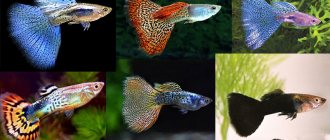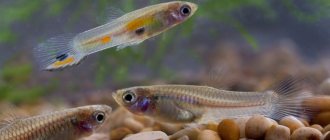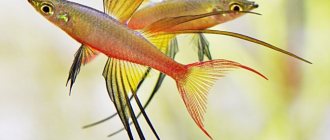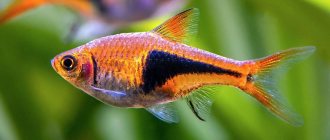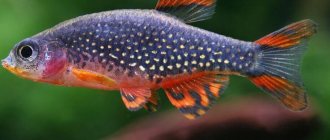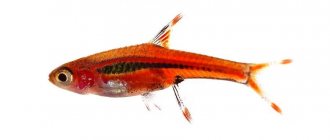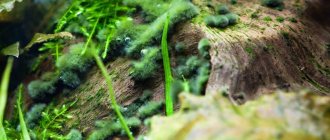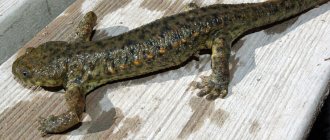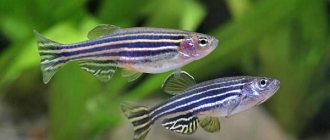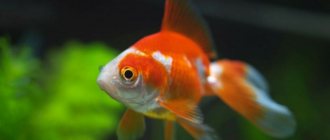Popondetta furcatus (Pseudomugil furcatus) iris, aquarium fish Popondetta furcatus (Pseudomugil furcatus) Nichols, 1955.
Synonyms
Russian: Popondetta furcata, Fork-tailed blue-eye, Pseudomugyl furcata Latin: Popondetta furcata (Nichols, 1955), Popondichthys furcatus (Nichols, 1955)
Etymology
Pseudomugil: From Ancient Greek (pseudes), meaning "lie, untruth", used here as a prefix and the generic name Mugil. furcatus: From the Latin furcatus, meaning "forked" in reference to the shape of the caudal fin in this species.
Order: Atheriniformes Family: Irisworts (Melanotaeniidae) Genus: Pseudomugil
Description
The fish is brightly colored and looks very noticeable even with its relatively small size - 4-5 cm. The body is elongated, round, with prominent large fins: dorsal, pectoral and anal. The main background of the body is blue-green, there are bright yellow accents: spots on the abdomen, on the dorsal fins, the pectoral fins are completely yellow. The eyes are blue with a black pupil and edging, for which the fish was nicknamed blue-eyed.
Appearance Features
Popondetta furcata is a very beautiful and colorful fish. Appearance:
- Size . The body length of an adult varies from 3 to 3.5 cm.
- Fins . The dorsal fin is double, with a small gap between the two halves, one of which is longer. A yellow edging stripe runs along the edges of each fin. The pectoral fin has rays colored alternating black and yellow.
- The main color is yellow with red tints. The front of the abdomen near the head is red.
- Eyes – a distinctive feature and pride of fish. They are bright blue, large, with a black round pupil. For the beauty of its eyes, the popondetta furcata was nicknamed “blue-eyed”.
Differences between males and females:
- Color – males have more saturated and bright shades.
- Fins - in males, the dorsal one is more elongated and larger in size. In females, the caudal fin is yellow with rays of black stripes, the remaining fins are colorless and transparent.
The beauty and brightness of representatives of this species is complemented by incredible grace and elegance of movements.
How to keep a popondetta furcata
In order for the fish to remain healthy and active, it needs good conditions. It's easy to create them.
Arrangement of the aquarium
- Volume – for a flock of 6 individuals, 40-50 liters will be enough. It is not recommended to keep less than six fish: after all, the blue-eyed fish is used to living in the company of its own kind. A full flock of 30-40 individuals should be placed in an aquarium of 180 liters or more;
- Soil – sand or gravel with a fraction of 3-5 mm is suitable. Fish live in the upper layers, so the size and shape of the soil are not particularly important to them;
- Filtration and aeration are mandatory. It is better if the air is supplied through a separate compressor;
- Decor - an abundance of driftwood, grottoes, ceramic pipes, pots - places where you can hide;
- Living plants must be in large quantities. Popondettes hide in dense thickets of grass most of the day. You need to leave some space for swimming in a separate area in the center or on one side of the aquarium;
- Lighting is dim; plants floating on the surface are well suited for scattering bright rays of light;
- The presence of a lid is desirable, since if the fish is very frightened, it can jump out of the water.
Water parameters
- The temperature is 20-26°C, the fish easily adapts to the conditions, the main thing is that there are no sudden changes;
- Hardness 5-16°;
- Acidity 7.0-7.5 pH;
Maintenance and care
- Cleaning the soil with a siphon 2 times a month;
- Change a small amount of water weekly (about 1/4).
Habitat
In the wild, Popondetta furcata inhabits shallow rivers and streams of eastern Papua New Guinea. Fish love warm waters with dense thickets. When the dry season begins, the furcata popondetta moves into deep puddles and small lakes. Representatives of the species feel comfortable in both fresh and slightly brackish water. They are easily bred in captivity, easily adapting to any parameters of the artificial biosystem of the aquarium.
What to feed your popondetta
Popondettes are considered omnivores, but when choosing food you need to focus on the small size of the eater. The blue-eye will only eat what fits into her mouth. The basis of the diet is dry specialized food. You can sometimes give frozen natural food - daphnia, cyclops. Feeding the popondetta furcata must be balanced so that the fish lives as long as possible. By the way, about how long popondettes live. The life span is short - up to 2 years, like most small fish.
Keeping in an aquarium
An aquarium that resembles the popondette's natural habitat is best suited for keeping.
This means that you need clean water, a moderate current, a large number of plants, driftwood, and floating plants on the surface of the water.
If you want to breed, then moss, Javanese, flame or any other will not hurt.
The volume of the aquarium itself may be small, but it is better that it be more than 40 liters, since it is better to keep a popondette furcata in a flock of 6 or more individuals. It is in a pack that they reveal all the peculiarities of behavior, stop being afraid and create their own hierarchy.
These are fairly unpretentious fish, provided that the water is clean and does not contain excess nitrates and ammonia.
The water temperature is 23-26C, but they tolerate cooler water quite well. Water hardness is not particularly important, since it varies greatly in habitats, depending on the season. Acidity between 6.5 pH and 7.5 pH.
Behavior and Compatibility
In a home aquarium, fish behave very peacefully both towards their own kind and when adjacent to other fish. They do not conflict, do not fight for territory and food, but at the same time they are not able to stand up for themselves and defend themselves even from small predators. Mostly bluegills swim in the middle and upper layers of water and hide in thickets of plants. But they can arrange games and frolic to the delight of the owner.
You need to choose the same peaceful, accommodating and active representatives as your neighbors:
- Tetras;
- Neons;
- Guppy;
- Barbs.
Shrimp and catfish are also frequent neighbors of popondettes. By choosing such a company and decorating the aquarium with live plants, the aquarist gets a real biotope, a natural corner at home.
Compatibility
Peaceful, well suited for keeping in a community aquarium, provided that the neighbors are also peaceful. Pseudomugil furcatus is a schooling fish, and it is better to keep 8-10 individuals, in which case they look more efficient and feel safe.
Males also behave more lively and are more brightly colored when there are other males in the flock with whom they compete for the attention of the female.
You can keep it with other types of iris: neon, Werner's iriatherina, small characins and tetras, barbs and even shrimp.
How to determine gender
The fish are ready to mate at the age of 5-6 months. Their period of fertility (that is, the ability to reproduce) is short; by one year, almost all the eggs that the female lays turn out to be infertile. Therefore, it is better to hurry up with reproduction. Sexual differences are well expressed: males are especially brightly colored. Their fins are longer than those of females, sometimes with a reddish tint. Females are more modest. In order for breeding to be successful, it is recommended to keep equal numbers of males and females in one flock.
Sexual Dimorphism
Males are slimmer and brighter than females, and their unpaired fins noticeably lengthen as they grow older.
Popondetta furcatus (P. furcatus) male
Popondetta furcatus (P. furcatus) female
They become sexually mature at 3-4 months.
Breeding
Due to the fact that popondettes can easily reproduce in an aquarium, they have gained such popularity. Nowadays it is almost impossible to find wild-caught fish in a pet store. Animal lovers prefer to breed blue-eyes at home, bred in captivity; they adapt much better to the conditions of detention. True, individuals obtained from inbreeding do not differ in health, so it is recommended to carefully approach the issue of choosing fish if breeding is planned.
Popondette breeding process
To initiate the process, you need to gradually raise the temperature in the aquarium over several days. This is done using a conventional heater with a thermostat. It is not necessary to place pairs in the spawning tank; this is unnecessary stress for the fish.
If breeding is planned in a community aquarium, it is better to cover the bottom with moss before spawning: this way the eggs will be better preserved and it will be more convenient to observe them. You also need to take care of the thickets: in dense, impassable thickets, many more fry will remain alive.
In some cases, placement in a spawning tank is necessary (for example, if there are a lot of fish in the main aquarium, or in addition to popondettes, there are other representatives there). Then the conditions are created:
- Bottom without substrate;
- At the bottom - moss or synthetic threads;
- Filter;
- Aerator.
Volume – up to 30 liters. 6 individuals are transplanted into it: three males and three females. The water parameters are initially similar to usual, then the water temperature gradually increases.
After the temperature rises by 2-3 degrees, the females begin to lay eggs. In the first days, you need to carefully monitor the eggs: remove the infertile (white) and fungus-affected eggs, and transfer the fertilized ones to another tank for maturation. The fish are deprived of parental responsibility, so they can hunt for fry and eat freshly spawned eggs.
Spawning takes place within one day. If it occurred in a spawning area, the parents are returned to the general aquarium, and the incubated eggs are returned to the spawning area. The fry are fed with Artemia nauplii and live dust (ciliates), then switch to starter food.
Reproduction and spawning
Popondetta furcata is a spawn-laying species. Like most aquarium fish, representatives of this species have absolutely no parental instinct. They do not care for the fry and even eat them at the first opportunity.
It is not recommended to reproduce offspring from the same sires.
As a result, the fry will become weaker with each generation, the adults will begin to get sick, and their life expectancy will decrease.
Preparing for spawning:
- Stimulation . To stimulate spawning, it is enough to increase the water temperature by a few degrees.
- Preparing the spawning tank . In order for spawning to be successful, a small flock consisting of several females and a male is placed in a separate tank. You need to put moss in the spawning tank and install a filter.
Spawning can also take place in a community aquarium. If the tank is equipped with a large number of dense plant crops and various shelters, the probability of survival of the fry is very high. Spawning in a community aquarium is preferred since the fish will be in an environment as close as possible to their natural habitat.
Spawning . Within 1-2 days, the female lays eggs. The eggs fall to the moss or bottom. During spawning, a male can mate with 2 or more females. The incubation period lasts several days. Every day the aquarist should inspect the moss for eggs. The eggs should be immediately transferred to a separate tank. When transplanting into a separate container, the eggs should be carefully inspected. If you come across infertile ones or those affected by fungus, they need to be removed.
Caring for offspring. After hatching, the fry hide between plants and in grottoes. When they grow a little and begin to swim out of their shelters, they need to be fed.
The fry's first menu is a microworm, brine shrimp, and industrial feed.
Portions of food should be small and should be given several times throughout the day. Remains of food must be removed from the surface of the water so as not to pollute it.
Popondetta furcata fry are extremely sensitive to water quality. Therefore, in the general aquarium or spawning tank where they live, the water should be changed every day. It is recommended to add a special water conditioner that contains methyl blue. This product will help keep the water clean and prevent the appearance of fungi in it.
Diseases of fork-tailed bluegills
The fish's immunity is strong enough for their small size. However, if the aquarium becomes “sick” with parasites, the popondettes will immediately pick them up. They are especially prone to oodynia. This disease is caused by skin parasites and causes itching and suffering for the fish. It can only be treated in the early stages with special antibacterial compounds.
Prevention of any diseases, including odoniosis - cleanliness of equipment for caring for the aquarium, constantly running filter and compressor, which create a flow of water. Without movement, water quickly turns into a swamp, in which parasites, bacteria and viruses multiply especially intensively.
Possible diseases
Popondetta furcata is a fish with fairly good health. But if not maintained correctly, they are susceptible to oodinosis. This is a parasitic disease that occurs as a result of prolonged exposure of fish to dirty water.
Symptoms : the appearance of golden or gray dots on the body, lethargy, sinking to the bottom.
Therapy. In the early stages, the disease can be cured with drugs that contain copper. During the treatment period, sick individuals should be transplanted into a separate tank. If the disease was detected in late stages, the fish cannot be saved. Prevention of disease - maintaining cleanliness and proper water quality in the aquarium.
Popondetta furcata is an amazing aquarium resident. The miniature size of the fish is more than compensated by its bright appearance, easy-going character and playfulness. You can spend hours watching the fish gracefully crossing the waters of the aquarium in a golden flock. They are unpretentious in maintenance, but require high-quality, clean water.
Arrangement of the aquarium
The volume of an aquarium for a small school of fish starts from 60 liters. The design uses a variety of rooted and floating plants arranged in groups; a few snags in the form of tree roots or branches will also not be out of place. When choosing and installing equipment, it is worth remembering that the Fork-tailed Blueeye prefers subdued lighting levels and oxygen-rich water, and also does not tolerate water flow, so select appropriate lighting and filtration systems.
Fish diseases
Health problems arise only in case of injury or when kept in inappropriate conditions, which suppresses the immune system and, as a result, provokes the occurrence of any disease. If the first symptoms appear, it is first necessary to check the water for excess of certain indicators or the presence of dangerous concentrations of toxic substances (nitrites, nitrates, ammonium, etc.). If deviations are detected, bring all values back to normal and only then begin treatment. Read more about symptoms and treatment methods in the section “Diseases of aquarium fish”.
Difficulty in content
Popondetta furcata is a very hardy fish, which, if you follow all the rules for care and feeding, does not cause any particular difficulties in keeping and breeding. The only caveat that needs to be considered before purchasing one is that they cannot live alone or in pairs. In this case, they will certainly begin to get sick and subsequently die. They need a flock of at least six individuals. If there is an equal number of females and males, then the latter can attack the former, although they do not harm them, but apparently just want to show their superiority. If the number of females prevails, then they will be able to restrain the excessive activity of males.
Keeping in an aquarium
For popondetta furcata, it is advisable to choose a long rectangular aquarium. She is very active and spends most of her time near the surface, swimming from wall to wall and playing. The arrangement of the container must be carried out taking into account all the features of its natural habitat.
Aquarium dimensions
A small flock (six individuals) can be kept in an aquarium of at least forty liters in volume. If you have the opportunity to purchase and install in your home a container with a volume of about two hundred liters, then you can start a team of fish of up to forty pieces. This will allow you to get great pleasure from watching the games of these bright exotic beauties, which helps relieve stress, improve your mood and generally strengthen the nervous system.
Lighting
For a comfortable stay for the popondette furcate, moderate lighting and daylight hours of about nine hours are sufficient.
Soil and plants
To arrange the bottom of the aquarium, the soil can be small or medium pebbles, as well as gravel. If sand is used, it must have a coarse fraction. The optimal layer thickness is at least five centimeters.
Popondetta furcata requires a lot of vegetation in the aquarium. Since these fish love to hide, you need to provide them with this opportunity. To decorate the container with greens, you can take any non-poisonous plants, with the exception of riccia, duckweed and similar species. They strongly tighten the surface of the water, which creates discomfort for the fish, which spend most of their time in the upper layer of water. The remaining plants can be planted in the ground by adding a mixture of clay and peat to the planting sites. It is best to place them at the back wall of the aquarium, so they will not interfere with the movement of active fish. It is advisable to add a small amount of cladophora algae and Java moss, as well as intricate driftwood, to the container. This will add even more decorative value to the arrangement of the tank, and a beautiful and well-kept aquarium helps create an atmosphere of comfort and coziness in the house, and also, for example, helps maintain a calm, friendly conversation.
Water parameters
The composition of the water with which the aquarium for popondetta furcata is filled should not include nitrates and ammonia. Its optimal temperature ranges from twenty-five to twenty-eight degrees. Although these fish feel good in cooler water, but not below twenty degrees. To maintain the temperature in the aquarium at a constant level, you need to purchase a special heater that contains a temperature sensor and a temperature controller. Water hardness can be neglected, since in the wild it, unlike temperature, is subject to strong fluctuations at different times of the year. As for acidity, it can be sour or neutral. Every week you need to replace one third of the water from the aquarium with fresh water. You should not completely change it unless necessary, as this deprives the fish of their usual habitat, which creates a stressful situation.
Filtration and aeration
A prerequisite for proper maintenance of popondetta, close to its natural environment, is a constant flow of water. To do this, you will need a special filter that can create a flow simulation. It is also necessary to carry out aeration, especially in large aquariums, in order to ensure a sufficient supply of oxygen.
Feeding
When kept in aquariums, it is advisable to feed this type of fish with live or frozen food. These can be daphnia, brine shrimp, cyclops, and tubifex. Since popondetta furcata is very small in size, both live and dry food must be thoroughly crushed. Industrial food for aquarium fish can be produced in flakes, granules or tablets. Of course, they are more convenient to use (long shelf life, balanced composition, etc.), in addition, nowadays you can find special food to enhance color, with an increased amount of protein or vitamins and minerals, as well as the one that is required for feeding fry . However, it is impossible to feed the fish only with it, since the lack of live food leads to a slowdown in the growth and development of the popondetta and loss of the ability to reproduce. The average price for a one hundred milliliter can of food, depending on the manufacturer and purpose, ranges from one hundred to five hundred rubles.
Compatibility with other fish
Distinguished by its peaceful disposition, the popondetta furcata takes root well in a community aquarium, provided that its neighbors also behave relatively calmly.
Compatible types include:
- Rainbows;
- Iriaterin Werner;
- Small size characins;
- Tetr;
- Barbusov;
- Corridors;
- Microassembling the galaxy;
- Danio;
- Shrimp.
Separately, I would like to mention special genetically modified fluorescent (self-luminous) fish – GloFish. They were developed by inserting DNA fragments from jellyfish or corals. It is these foreign proteins that allow the fish to emit a bright glow in ultraviolet rays.
Based on Danio-reo, such varieties of fluorescent fish as “Red Star”, “Electric Green”, “Solar Orange”, “Cosmic Blue”, “Galactic Purple” were obtained. And based on the common thorn - the green Sumatran barb.
Incompatible types:
- Cichlids;
- Goldfish;
- Koi carp;
- Astronotuses.
Popondetta furcata diseases
Popondetta furcata is very prone to infection with velvet disease (oodiniasis). The disease is parasitic, and its development is provoked by old water in the aquarium. It is formed as a result of the lack of weekly replacement of part of the water volume and when the artificial flow is too weak.
When fish are infected with oodiniosis, their bodies begin to become covered with dots of golden or gray color. They often begin to sink to the ground and constantly rub against it, as well as against all solid decor. Over time, the skin of the fish becomes covered with grayish-brown spots and begins to peel off, the fins stick together and collapse. This disease develops quite quickly and, as a rule, in its later stages it is no longer possible to save pets.
If you manage to catch the disease at the beginning of its development, you can try, after consulting with a veterinarian, treatment with special preparations containing copper. The fish need to be placed in a separate container with a water temperature of about twenty-five degrees and good aeration, and then treated in accordance with the instructions on the medicine packaging. The treatment may have to be repeated several times until the parasites are completely destroyed. A common contaminated aquarium does not need to be emptied of water; to disinfect it, you need to increase the water temperature to twenty-eight degrees and provide very bright lighting for five days. Since the bacteria that cause this disease cannot live without fish, during this time they will self-destruct and the treated individuals can be returned back. All items that were used at this time to work with the aquarium must be treated with alcohol or a strong solution of potassium permanganate.
In order to prevent your pets from becoming infected, you need to follow the usual preventive measures:
- Always ensure that the water in the aquarium is clean;
- Inspect the fish for integrity; if they have wounds on the body or damaged fins, treatment should be started immediately;
- Place snails in the container, which will destroy excess algae on the walls;
- Clean the filter monthly.
Lifespan
The lifespan of this type of fish living at home does not exceed two years. Although in the wild it is not much larger, for individuals of this size, this is quite a common occurrence.
Purchase and average price
When planning to purchase this type of fish, you first need to decide on the volume of the aquarium and calculate how many individuals can be placed in it. Then you need to study all the available information about them. After this, you need to visit a number of pet stores and choose the one that will best meet the requirements: cleanliness of the room and the aquarium itself, the presence of the name of the fish and their price on each container, experienced specialists ready to give appropriate advice.
A healthy individual should be active, have a color characteristic of its species and straightened fins. You should not buy fish that are too small for their age, they may be sick. Also, you should not give preference to ones that are too large; most likely they are old, weak and prone to diseases, and the lifespan of popandetta furcata is not very long anyway. The average cost of a fish is about two hundred and fifty rubles.
Compatibility of popondetta furcata with other fish
This fish has a rather peaceful disposition. Compatibility of popondetta furcata with other inhabitants of the aquarium is normal, if the neighbors also turn out to be peaceful. Lovely and peaceful popondette next door to:
- Rainbows;
- Kharashchinova small sizes;
- Tetras;
- Barbs;
- Corridors;
- Danio;
- Shrimp.
Popondettes are completely incompatible with the following fish:
- Cichlids;
- Goldfish;
- Koi carp;
- Astronotuses.
Description of popondetta furcata
Popondetta furcata is a small, schooling, incredibly beautiful, active and playful fish. On average, its body, elongated and flattened on the sides, is up to 4 cm long. There have been cases of encounters with large species of popondetta fish, the length of which was up to 6-15 cm.
There are a huge number of different rainbow fish. But this one in particular attracts attention because it has a truly unusual color and fin structure.
The fins on the abdomen are a rich yellow color. The pectoral fins are transparent, and the edges are colored in the same chic yellow tone. The fins on the back are forked. The first one is much longer than the second one.
The second, in turn, is relatively wider. The dorsal fins are extremely charming with their transparency mixed with pale yellow-green tones. The tail of the blue-eyed popondetta is also deep yellow with dark stripes along it. The two caudal fins are separated by a dark brown triangle.
The popondetta furcata in the photo conveys all its charm and beauty. In real life it is difficult to take your eyes off her. Once again I would like to emphasize the incredibly beautiful color of the eyes of the fork-tailed popondetta. They have an amazing ability to fascinate and attract the views of all people without exception.
Habitat
Endemic to the island of New Guinea, it lives in the river basins flowing into Collingwood Bay and Ackland Dyke, washing the eastern tip of the island.
Prefers clean and calm sections of rivers rich in aquatic vegetation, flowing among tropical forests. Natural habitats are subject to seasonal changes. During monsoon periods, heavy rainfall increases water levels in rivers, lowering temperatures and washing out a lot of organic matter from the forest floor. During dry periods, partial drying out of small river beds is not uncommon. Brief information:
- Aquarium volume - from 60 liters.
- Temperature - 24–28°C
- pH value – 7.0–8.0
- Water hardness - medium to high (15–30 dGH)
- Substrate type - any
- Lighting - dim
- Brackish water - no
- Water movement is weak
- The size of the fish is up to 6 cm.
- Food - any
- Temperament - peaceful
- Keeping a school of at least 8–10 individuals
